By volunteer
By Bill Napper, Volunteer Naturalist
 Among the myriad of creatures that call the Bernheim forests and wetlands home, frogs in particular charm us with their captivating presence and enchanting songs. That is why for the past decade, Bernheim’s April full moon programs have been thematically dubbed the Full “Frog” Moon – because they celebrate these extraordinary creatures. Most of the modern world refers to April’s full moon as the “Pink” Moon, a name derived from the Old Farmer’s Almanac and inspired by the profusion of beautiful spring flowers that blossom during this time. Undoubtedly, “Pink” Moon possesses an entrancing charm; yet, we at Bernheim find ourselves aligning with the wisdom of several Native American tribes who christened April’s full moon as the “Frog” Moon. There is a synergy between the moon and frogs that truly captivates the nights in warmer months. The moon’s luminous presence pays tribute to their nightly serenades, whereas flowers, with their sun-kissed splendor, seem more akin to the realm of day.
Among the myriad of creatures that call the Bernheim forests and wetlands home, frogs in particular charm us with their captivating presence and enchanting songs. That is why for the past decade, Bernheim’s April full moon programs have been thematically dubbed the Full “Frog” Moon – because they celebrate these extraordinary creatures. Most of the modern world refers to April’s full moon as the “Pink” Moon, a name derived from the Old Farmer’s Almanac and inspired by the profusion of beautiful spring flowers that blossom during this time. Undoubtedly, “Pink” Moon possesses an entrancing charm; yet, we at Bernheim find ourselves aligning with the wisdom of several Native American tribes who christened April’s full moon as the “Frog” Moon. There is a synergy between the moon and frogs that truly captivates the nights in warmer months. The moon’s luminous presence pays tribute to their nightly serenades, whereas flowers, with their sun-kissed splendor, seem more akin to the realm of day.
Bernheim’s diverse ecosystem boasts at least 17 distinct frog species. Although these amphibian virtuosos do not all vocalize simultaneously throughout the year, some have overlapping breeding seasons, offering a delightful blend of frog calls during the warmer months, especially during our full moon hikes. In fact, recent studies suggest frogs keep a close eye on the moon cycles and use them as cues to allow them to synchronize their explosive breeding events.
On our April, May, and June full moon hikes, beneath the moon’s gaze, the tranquil shores of Lake Nevin come alive as we are serenaded by up to six different frog species, each contributing their distinct melodies to the harmonious nocturnal chorus.

Cope’s Gray Treefrog
Often, the first frog to serenade us is the cope’s gray treefrog (Hyla chrysoscelis). These delightful little creatures like to hang out in the magnolia trees near the Garden Pavillion, which is usually where we commence our hike. As daylight wanes, the males begin calling, softly and slowly. They frequently pause for several seconds between each of their loud trills, creating a relaxed ambiance that is sure to help you alleviate the day’s stress.
These nimble climbers possess specially adapted, cute tiny finger-looking, sticky toe pads, enabling them to effortlessly ascend trees and cling to branches, leaves, and even glass surfaces. As they nestle against their tree, they expertly camouflage themselves, merging with their surroundings, and they can be easily mistaken for a small patch of lichen on the tree.
Soon after we begin our hike, and just a short walk away, our next performers come into earshot and we begin to hear the calls of the cricket frog and leopard frog.
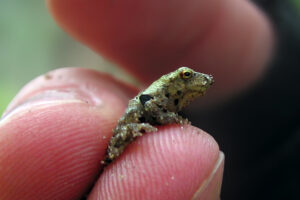
Northern Cricket and Leopard Frogs
The northern cricket frog’s (Acris crepitans) call starkly contrasts with the mellow sounds of the cope’s gray treefrog. Despite its small size, no bigger than your thumbnail when fully grown, the cricket frog’s call is surprisingly loud and distinctive. These little guys are quite the chatterboxes! Male cricket frogs gather in groups and produce a series of rapid clicks, often likened to the sound of two marbles being struck together. The sound generates an atmosphere of excitement, as though the frogs are saying, “let’s get busy!”
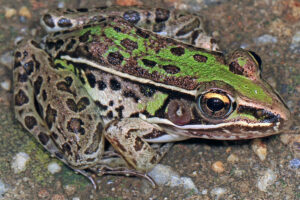
Leopard Frogs
At Bernheim, we have two species of leopard frogs, each with its own unique quirky sounds. While the southern leopard frog (Rana utricularia) is the more vocal of the pair due to its extended breeding season, both have surprisingly peculiar calls that will leave you scratching your head. Imagine running your hands over an inflated balloon and attempting to mimic a range of odd noises like grunts, growls, and chuckles – that’s what the southern leopard frog sounds like! Trust us, you genuinely have to hear it to appreciate its comedic value.
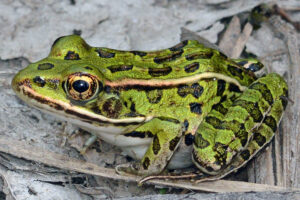
The northern leopard frog (Rana pipiens), on the other hand, is a different kind of weird. Its mating call resembles an extended, rattling snore, persisting for several seconds – almost as though it prefers catching some extra sleep rather than attracting a partner! Despite their seemingly laid-back style, these frogs are experts at understanding what females desire, and their consistent presence year after year attests to that. To experience genuine froggy humor, come and listen to our leopard frogs in Bernheim!
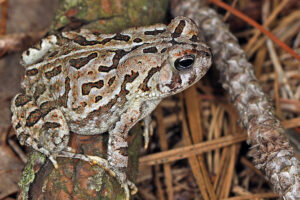
Toads
As we stroll around Lake Nevin, the ecosystem gradually transforms, and we start to hear fresh frog sounds. Now, allow me to introduce the Bernheim toads. You may wonder, “What’s the difference between frogs and toads?” While they seem similar, distinctions abound. As my frog mentor, Joe Chichan, aka “Bernheim’s Frogman”, taught me: “All toads are frogs but not all frogs are toads.” Turns out, the distinctions between frogs and toads are many: nose shape, skin appearance, leg length, and more. For now, let’s concentrate on their sounds.
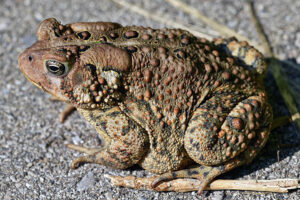
Bernheim (and Kentucky) are home to two prevalent toads: the Fowler’s toad (Anaxyrus fowleri) and the American toad (Anaxyrus americanus). When it comes to sound, these two couldn’t be more different. Many have attempted to describe the Fowler’s toad call; frankly, all have been too kind. Here are some of the descriptions I’ve heard: a crying baby, a nasal “waaa” lasting two to five seconds, a sheep-like bleat lasting one to four seconds, an unmusical “waaa” akin to a sheep in distress, and a prolonged shrill or “muffled scream from a distressed sheep.” All I can say is that the call is loud, grating, and so dreadful it’s adorable. Fowler’s toads leave an impression, and hearing their call is always a highlight of our hike.
What about the American toad? Judging by its warty skin, one could easily overlook its true beauty—its melodious voice. While descriptions of the Fowler’s toad voice may be overly generous, those of the American toad often lack the well-deserved praise. Standard scientific descriptions merely state it has a high-pitched trill that lasts 20 to 30 seconds. Yet, among Bernheim’s sonic symphony, the American toad is a melodic gem and my personal favorite.
Similar to many frogs, the males assemble and sing in unison to better attract female attention. Each individual call softly emerges, swelling in volume and harmoniously overlapping with others, fading as another takes its place. The result is a captivating, continuous choir of a hundred trilling voices that enchant and soothe the soul.
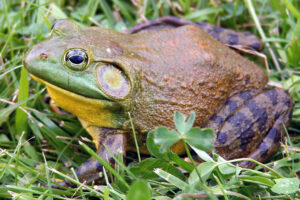
American Bullfrogs and Green Frogs
Approaching the southern bridges of Lake Nevin, new frog voices emerge, deep and grand, echoing into the night air. We’ve entered the lake area favored by American bullfrogs (Rana catesbeiana) and green frogs (Rana clamitans). At this point, you might think that with all the remarkable frog voices described earlier, these two species would face stiff competition. Rest assured, both bullfrogs and green frogs confidently claim their aquatic stage.
The American bullfrog, a cherished figure in tales and tunes, is the largest US frog with a robust voice to match. Its name likely derives from its bellowing bull-like call. My favorite description of its deep, thunderous voice is “Jug-o-rum, jug-o-rum, jug-o-rum.”
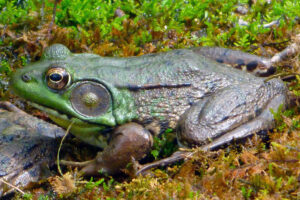
Intermingled with the mighty American bullfrog ensemble, a curious, whimsical sound arises, as if someone were clumsily plucking at a loose banjo string. This banjo twang is the love song of the male green frog. Seen in daylight, green frogs are often mistaken for their bigger, bolder cousins, the American bullfrogs. At night, they are the perfect quirky, comedic sidekick to the boisterous American bullfrog lead.
“Frogs do for the night what birds do for the day: They give it a voice,” said renowned herpetologist Archie Carr, “and the voice is a varied and stirring one that ought to be better known.”
Do yourself a favor and jump at the chance to join us on one of our spring/summer full moon hikes and experience the enchanting symphony of these remarkable frogs firsthand. Secure your spot now and immerse yourself in the captivating world of our fabulous, fascinating, and funny moonstruck amphibians!

